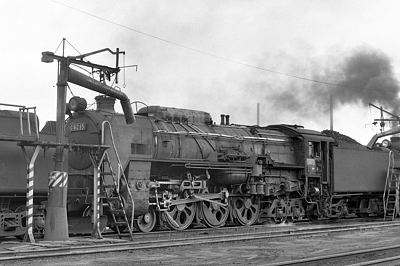
Shown here we see C62_15 standing by
to pull the return express "Niseko" waiting
at Otaru-Chikko depot.
Japanese
|
1947 - 1971 (1973) The largest passenger type Tender-Engine for arterial and main line express passenger trains. |

Shown here we see C62_15 standing by to pull the return express "Niseko" waiting at Otaru-Chikko depot. |
|
The design background of the C62 was the same as that of the C61. Thus after WW2, the question as to how to dispose of surplus freight engines and answer the need for the deficiency of passenger engines was answered. So, the big passenger engine C62 was designed from the reconstruction of the largest freight engine D52. The upperbody boiler and other parts were diverted from the D52. And the travel unit was constructed from the basis of the C59's design, and the axle was arranged to 4-6-4. Therefore the C62 became the largest passenger model in Japan for the arterial railroad express of 1,620 HP. The first C62 was remodeled from D52_74 at the Hitachi Co. during January 1948. About C62_1 consult please Umekoji Museum's C62_1 and C62_2 page. A total of 49 C62's were reconstructed during 1947-1949. After its appearance, they were deployed to Tohoku, Tokaido and Sanyo lines, with the commonly used C59. Deployment list during May 1951
Afterward, C62's were mainly directed to the Hamamatsu, Nagoya, Umekoji(Kyoto), Miyahara(Osaka), Itozaki, Hiroshima and Shimonoseki depots for the increased use of express trains. During the 1956-1958 period, the D52's old boiler was redesigned. Therefore, the C62 became a new model in reality.
Seven engines were released from the electrified Tokaido line during 1956 and were moved to the Hakodate line in Hokkaido, with a lightweight axle load. The weeding out of C62's began from the Sanyo electrified line in 1964. During 1964 deployment was as follows : 6 in the Otaru-Chikko depot (No.2, 3, 27, 30, 32 and 44) for the Hakodate line. 3 in the Sendai depot (No.7, 9 and 11) for the Jyoban line, 12 in the Taira depot (No.10, 22, 23, 24, 37, 38, 39 and 45-49) for the Jyoban line, 6 in the Itozaki depot (No.5, 16, 17, 34, 35 and 40) for the Sanyo and Kure line, 16 in the Hiroshima depot (No.1, 6, 12-15, 18, 25, 26, 28, 29, 31, 33, 36, 41 and 43) for the Sanyo line, ... total 43. However, Sanyo lines C62 disappeared by electrification during Jul 1964. Jyoban line was also electrified during July 1967, and Kure line saw electrification during September 1970...... Finally, four C62's (No. 2, 3, 15 and 16) survived on the Hakodate line between Otaru and Hakodate in Otaru-Chikko depot. Otaru-Chikko's C62 operated express "Teine", "Marimo" and "Niseko" by double-headed between Otaru and Oshamanbe. Japanese rail-fans were excited by the scene of Japan's biggest engine going over a pass with double-headed operations. However, Otaru-Chikko's C62s were retired by 1971 as a last service of the C62 from regular service. (irregular service continued until Sept. 1973 by C62_3). |
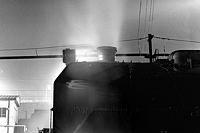
|
Seen here on the left side, with a pictured swallow (Tsubame) on her smoke deflector,
C62 No.2, the Super Express "Tsubame ".(worked during 1949-1956) C62_2 now restored at Umekoji Museum. Otaru-Chikko depot, Mar 1971 |
| Primary ran line in last 10 years |
Hakodate, Jyoban, Tohoku, Kure
| Last line/depot and year |
Hakodate line / Otaru-Tittko depot 1971 (Restored until Sept 1973)
| Restored engine (2017) |
1 (No.2)
| Preserved engine (2017) |
4 (No.1, 3, 17, 26)
| |
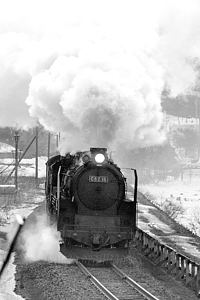
|
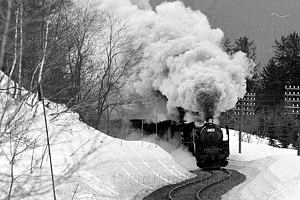
| ||||||||
|
Express "Niseko" pulling C62 No.16. at Onuma, Hakodate line Mar 1971. |
Under full steam pulling the express with double headed C62_2 + C62_16. Kozawa, Hakodate line Mar 1971.
| 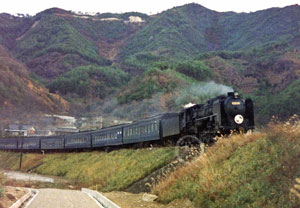
| 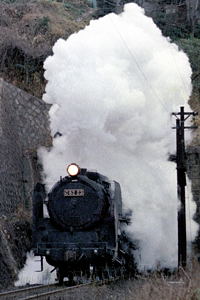
Shown here is a C62_16 express | from Hiroshima to Itozaki during Dec.1968 on the Kure line. Note the marking, "AKI" (old Hiroshima name) on its head.
C62_23 emerging from a tunnel bathed | in steam and smoke in this winter scene. Koyaura Kure line. Dec 1969.
| 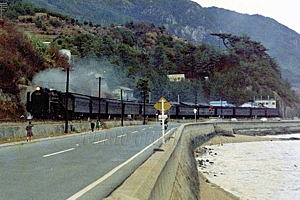
| 
C62_41 Kure line, Dec 1969 |
C62_15 Tenno, Kure line. | Dec 1969 |

| Configuration | 4-6-4 | Dimensions Length (mm) | 21475 |
| Engine Weight (Operating tons) | 88.8 | Driver size (mm diameter) | 1750 |
| Boiler pressure (Kg/cm2) | 16.0 | Max Tractive effort (tons) | 12.1(11.2) |
| Driver Max Power (PS) | 1620 | Max Speed (km/h) | 100 |
| Manufactured years | 1947-1949 | Total production | 49 |
| Gauge | 3ft 6in (1067mm) |
* Parenthetic ; Light model |
Introduction |
Go to Top |